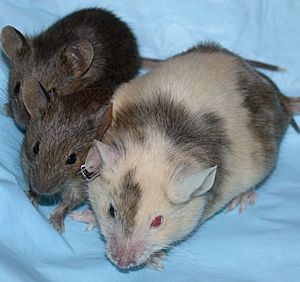Beatrice Mintz facts for kids
Quick facts for kids
Beatrice Mintz
|
|
|---|---|
 |
|
| Born | January 24, 1921 New York City, U.S.
|
| Died | January 3, 2022 (aged 100) Elkins Park, Pennsylvania, U.S.
|
| Nationality | American |
| Alma mater | Hunter College and University of Iowa |
| Known for | Mammalian transgenesis |
| Awards | Rosenstiel Award (1979) Genetics Society of America Medal (1981) Ernst Jung Gold Medal for Medicine (1990) March of Dimes Prize in Developmental Biology (1996) Pearl Meister Greengard Prize (2007) Szent-Györgyi Prize for Progress in Cancer Research (2011) |
| Scientific career | |
| Fields | Embryology, Developmental biology |
| Institutions | University of Chicago Fox Chase Cancer Center |
| Doctoral advisor | Emil Witschi |
| Influenced | Rudolf Jaenisch |
Beatrice Mintz (born January 24, 1921 – died January 3, 2022) was an American scientist. She was a pioneer in the study of embryos and how living things develop. Her work helped us understand genetic changes, how cells become different types, and how cancer grows, especially a skin cancer called melanoma.
Dr. Mintz was one of the first scientists to create both chimeric and transgenic mammals. Chimeric animals have cells from two or more different sources. Transgenic animals have new genetic material added to them.
In 1996, she received the first March of Dimes Prize in Developmental Biology. She shared this award with Ralph L. Brinster for their work on creating transgenic mice. Most of her career was spent at the Fox Chase Cancer Center in Philadelphia.
Contents
Early Life and Education
Beatrice Mintz was born in New York City on January 24, 1921. Her parents were Samuel and Janie Stein Mintz. They were a Jewish family from a place called Mikulintsy, which is now in Ukraine.
She graduated with high honors from Hunter College in 1941. She then studied at New York University for a year. Because of rules that limited Jewish students at some colleges, she went to the University of Iowa. There, she earned her master's degree in 1944 and her Ph.D. in 1946. She studied amphibians with her professor, Emil Witschi.
Amazing Research
After finishing her studies, Dr. Mintz became a professor at the University of Chicago from 1946 to 1960. She also spent time studying in Paris and Strasbourg, France. In 1960, she moved to the Institute for Cancer Research, which later became the Fox Chase Cancer Center. She stayed there for the rest of her career.
In the mid-1950s, Dr. Mintz changed her focus from amphibians to mammals. She became a leader in creating transgenic mammals. In 1965, she also became a professor at the University of Pennsylvania.
Creating Chimeric Mice
In the 1960s, Dr. Mintz and another scientist, Andrzej K. Tarkowski, were the first to create mouse embryonic chimeras. They did this by combining two very early mouse embryos. These combined embryos grew into normal mice. Their bodies had a mix of cells from both original embryos.
Dr. Mintz even created chimeric embryos using cells from up to fifteen different lab mice. She developed a special method. She would mix cells from a black mouse with cells from white or brown mouse embryos in a lab dish. Then, she would place these early embryos into a mother mouse. After the babies were born, she could see which parts of their bodies came from which original mouse by looking at their fur color.
Her method worked because she carefully removed the outer layer of the embryo. Since 1967, Dr. Mintz created over 25,000 offspring using this technique.
Understanding Cancer Cells
Dr. Mintz also showed that certain teratocarcinoma tumor cells could be "reprogrammed." These are special cancer cells that can grow into many different types of tissue. She combined these tumor cells with normal mouse embryo cells. She found that the tumor cells could contribute to a healthy mouse. This was a big step in understanding stem cells.
First Genetically Modified Mammals
In 1974, Dr. Mintz worked with Rudolf Jaenisch on a major breakthrough. Jaenisch was studying how viruses could cause cancer in adult mice. He wondered if injecting a virus into a very early embryo would change the embryo's DNA.
Dr. Mintz agreed to work with him. They showed that DNA from a virus could be added into the DNA of developing mice. This new DNA stayed in the mice as they grew up, and the mice remained healthy.
Even though these changes only affected the mouse itself and not its future babies, this was a huge discovery. It proved that healthy genetically modified mammals could be created. Using these methods, Dr. Mintz helped find the genetic causes of some cancers. In 1993, she created the first mouse model of human malignant melanoma. This means she made a mouse that developed melanoma, which helped scientists study the disease.
Awards and Honors
Dr. Mintz received many awards for her important work. Some of these include:
- The first Genetics Society of America Medal (1981).
- The first March of Dimes Prize in Developmental Biology (1996), shared with Ralph L. Brinster.
- The Ernst Jung Gold Medal for Medicine (1990).
- The Pearl Meister Greengard Prize (2007).
- The Szent-Gyorgyi Prize for Progress in Cancer Research (2011).
She was also chosen as a member of important groups like the American Academy of Arts and Sciences and the United States National Academy of Sciences. She received honorary degrees from five different universities.
Personal Life and Death
Beatrice Mintz passed away on January 3, 2022, just three weeks before her 101st birthday. She died from heart failure.
See also
 In Spanish: Beatrice Mintz para niños
In Spanish: Beatrice Mintz para niños


